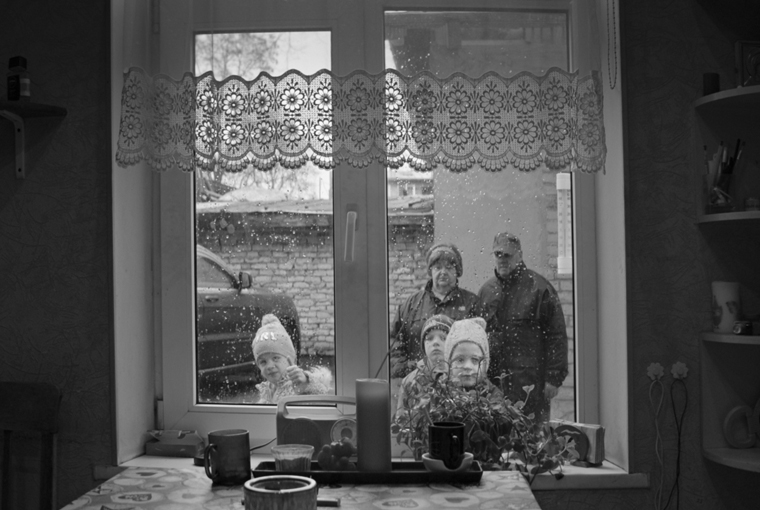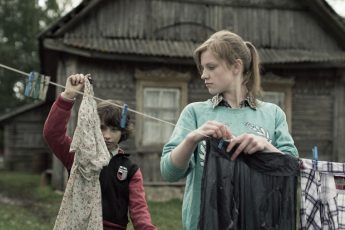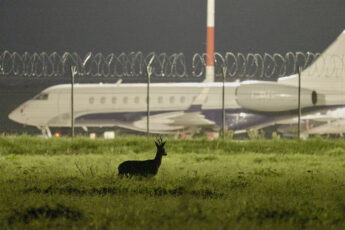Funny Frames: Observations on the Act of Documentary Filmmaking
Laila Pakalniņa’s Homes (Mājas, 2021)
Vol. 123 (March 2022) by Ana Grgić and Antonis Lagarias
Father: Look into the window!
Little girl: Why should I?
Father: A bird will fly out soon! And smile!
In Laila Pakalniņa’s latest film Homes, documentary subjects become both co-participants and directors in the filming “game” of staging a cinematic view. Reminiscent of nineteenth-century studio photography and the Albertian “window” (during the Renaissance, Leon Battista Alberti likened the process of conceiving a picture to looking through a window out into a section of the visible world),1 family portraits are constructed as framed by and through their own homes. Here taken literally, the participants are observed from inside their homes, through a window or windows, and given directions via a walkie-talkie to move a little to the left or to the right, retreat back or come forward, in an effort to create a balanced and aesthetically pleasing composition. Then, once positioned as Pakalniņa’s cinematographer Gints Bērziņš desires, they are directed to stand still while the camera continues to roll. “Just like a photograph”, Bērziņš informs them over the walkie-talkie, “except it will last a full minute”. Of course, nothing really stands still. Not the subjects, nor the pets or the trees, nor the neighbor walking in the background or a car speeding through the frame. If cinema is the machine par excellence of recording the flow of life, then it is in these moments that its nature may be located. By documenting this process of staging views, Pakalniņa invites the viewer to reflect on the process of documentary filmmaking. Moreover, it is suggested that this particular way of reflecting on the act of documentary filmmaking could itself become a complicit and, ideally, consensual act between the subject and the filmmaker.
The Latvian filmmaker Laila Pakalniņa graduated from the Moscow Film Institute (VGIK) in Film Direction in 1991 just as the Soviet bloc was collapsing. During her prolific and still very active film career, she has directed and scripted 32 documentaries, five shorts, and six fiction feature films. This year the 24th Thessaloniki Documentary Film Festival dedicated a tribute to her work, showcasing 19 films, among which her latest film Homes, which premiered at the IDFA festival in Amsterdam in 2021, played to a full house. Homes is her longest film to date (just over two hours). The filmmaker justified this length with not wanting to exclude any of the filmed subjects. As she revealed, Homes was initially intended to also include hand-held shots of each house as the crew entered, recording more details of the interior. However, after witnessing warm and surprisingly funny reactions to the window composition scenes, she decided to modify the original plan and exclusively keep the footage shot on a tripod, without editing out any of the homes visited.
Similar to the approach used throughout her previous work, Pakalniņa maintains a preference for long takes and no camera movement, allowing the reality to unravel in front of the lens. At first, the spectator may be unnerved by this stylistic approach, but very soon they get used to the slow and yet rhythmical exchange of film frames (views), as each adds another layer of complexity to the narrative as it unfolds, revealing more profound meanings and connections between the seemingly disconnected (or separate) mise-en-scènes. For instance, to understand the importance Pakalniņa places on the film structure and narration, one could turn to the end of the film, where we become privy to a TV or radio news item playing in the background, allowing us to read into the situation that the events are being filmed during the Covid pandemic. At this point in the narrative, the glass window, the boundary between the inside and the outside, acquires a new dimension. The camera and the filmmaker are now confined on the inside of the house, while the home dwellers are on the outside looking in at us. This acquires a particularly uncanny dimension in our Covid pandemic-stricken world, since we have undergone the experience, on an unprecedented scale, of being confined inside our homes for great lengths of time. Through this return of the gaze, we as the film spectator-voyeur begin to feel looked at, and moreover, in a sense, framed and confined inside the camera, and conversely, within our place of habitat. The reversal of the gaze and viewing perspective becomes an intriguing departure point for the film.
Diegetic sound also plays an important role. During the Q&A at Thessaloniki, Pakalniņa noted that, unlike most of her previous films, where sound was recreated in post-production, all the sound in Homes was recorded on location. Narratively important events, such as the radio broadcast linking the film to the pandemic, or the appearance of the last family, which questions the process of filmmaking and the role of special effects, are as accidental as real life. The presence of the camera and the attention to the surrounding sound only enable and reinforce what is already present. By patiently and astutely observing the most mundane of everyday events, Homes uncovers and observes the various strata of human behaviour and brings to light associations that would otherwise remain unnoticed. While the filmmaker and the camera are separated by a window or a frame at a certain distance, the dialogue, comments, and funny exchanges between the filmed subjects are audible and feel close. This incongruity between the visual distance and aural proximity seems to recall the lived reality of our world over the last two years, as most social, educational, work and leisure activities moved online, dividing us by a screen, mediating images of us and our surroundings. There is a process of defamiliarization and dedramatization brought to prominence in this process. Similar to the way diegetic sound (whether amplified or distorted) was used in her previous films such as The Mail, Papa Gena, or The Spoon, here the dialogues and exchanges between the family members as they struggle to stand still for one minute or feel compelled to give instructions to other family members, become a source of humor and irony. Neither the filmmaker nor the cinematographer intervene to interrupt the participants’ directions or comments. At the same time, we hear the cinematographer’s directions via the walkie-talkie as he guides them within the confines and the space of the film frame. Unlike in Pakalniņa’s previous films, where the instructions are concealed from the audience, in Homes, Bērziņš’ voice becomes a central aural (and perhaps narrative) point of reference that unifies the different scenes. As the film records both accidental sounds of everyday life and the intentional intervention of the filmmaking process, the cinematographer himself becomes a character. His reactions are observed with the same attention as the filmed subjects.
Ultimately, it is perhaps easy to see why Homes was the only film labelled as a “hybrid experimental documentary” by the organizers of the Thessaloniki Documentary Film Festival. In a way, each family scene reminds the audience of the classical analogy between filmmaking and hunting – established by the common verb used for both activities, “shooting”. In this case, the spontaneous humor of everyday life becomes Pakalniņa’s prey. While the camera rolls, life in front of the camera unfolds, despite and beyond the instructions given by the cinematographer who guides the subjects within the frame. In this way, when the unexpected occurs in sight (or when it becomes audible), the camera records it forever, simultaneously conveying to the audience the patience and excitement of the hunting/film-shooting process. And in that sense, Homes can be considered cinema in its purest form. Here is a film abounding with the excitement of a child who is engaged in the discovery and interaction with the phenomena and movements of the world, only to cherish them and share them with others.
References
- 1.See the often-quoted treatise by Leon Battista Alberti, De Pictura/On Painting, (2011[1435]), Cambridge University Press. Edited and translated by Rocco Sinisgalli; 39.




Leave a Comment